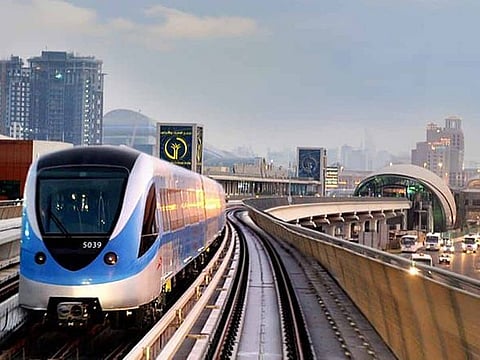RTA: 1 billion journeys on cars, Dh115 billion saved because of Dubai Metro since 2009
Dubai Metro, also helps reduce 2.6 million tons of carbon dioxide emissions

Dubai: Since its roll-out in September 2009, Dubai Metro has helped eliminate about one billion journeys on private vehicles — for a cumulative savings of around Dh115 billion and reduction in carbon dioxide emissions by 2.6 million tons.
The statement was made by Mattar Al Tayer, director general and chairman of the Board of Executive Directors at Roads and Transport Authority (RTA), at the 7th Dubai International Project Management Forum (DIPMF), where he spoke during a panel discussion titled ‘Sustainability and Mobility Projects’ on Thursday at Expo 2020 Dubai.
Al Tayer also talked about Dubai’s mega projects that had been accomplished by RTA in a record time without undermining quality and safety. He said: “The portfolio of such projects is highlighted by the Dubai Metro, the longest driverless metro system in the whole world. The metro network, which spans 74km, had been completed in just four years. The total length of the rail network is about 101km.”
“There is also the Dubai Water Canal Project, which was completed despite the associated complex challenges such as the route of the canal intersecting three main roads encompassing 28 traffic lanes in an area characterised by a complete infrastructure and a massive network of utility lines. RTA also accomplished a host of vital projects during the period of the Covid-19 pandemic exceeding USD5.5 billion in value involving Route 2020 for expanding the Dubai Metro, Dubai Intelligent Traffic Systems Centre at Al Barsha, Al Shindagha Corridor including the Infinity Bridge, and Al Khawaneej Corridor,” he continued.
Sustainable transport
Al Tayer noted: “The RTA has launched numerous projects and initiatives to boost the public and sustainable transport to increase the proportion of journeys made by sustainable modes and walk from 30 per cent in 2020 to more than 43 per cent by 2030.”
He added: “Besides mass transit means comprising the metro, tram and buses, mobility systems include taxi e-hail service, smart car rental (shared transport) service, bus on demand service, bike and scooter rental services besides expanding the use of smart technologies. For instance, nol card can be used in paying for purchases made at 12,000 retail outlets besides entry of Dubai’s public parks and museums.”
“The vision of our leader His Highness Sheikh Mohammed bin Rashid Al Maktoum, Vice-President, Prime Minister of the UAE, Ruler of Dubai, aims to make the Dubai the best city for living and doing business in the world. On this ground, the Dubai Master Urban Plan 2040 was set and focused on serving the inhabitants and achieving sustainable urban development,” Al Tayer underlined.
Smart technologies
Al Tayer said the future mobility is anchored on smart technologies. “Our leaders had anticipated the future trends of digital transformation and artificial intelligence at an early stage. In 2013, the Smart Dubai initiative was rolled out and in 2016, Dubai Strategy for Self-Driving Transport was launched with the aim to transform 25 per cent of total mobility journeys in Dubai into journeys on self-driving transport means by 2030,” he commented.
Al Tayer highlighted the key factors for adopting public transport as a key service in towns as maintaining effective communication with clients to identify their needs, and benefiting from the expertise of metropolitan cities to start from where they have ended. T
They also include selecting the most appropriate work model for the city, ensuring the flexibility of policies to adapt to the fast-changing developments of transport means, and making savings to strike a balance between transport needs and sustainability, which will pave the way for achieving high living standards.
Sign up for the Daily Briefing
Get the latest news and updates straight to your inbox



